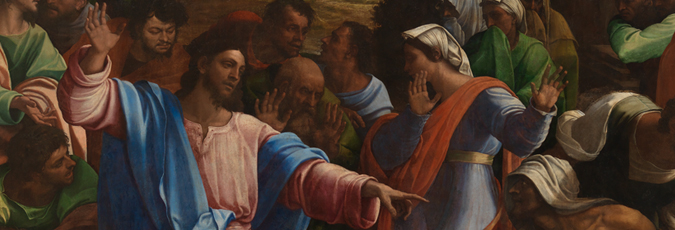Death and resurrection
Michelangelo and Sebastiano's first collaboration was 'Lamentation over the Dead Christ', also known as the 'Pietà' (about 1512–16), for the church of S. Francesco in Viterbo. Michelangelo had already sculpted this subject for the Vatican ‘Pietà’ (1497–1500). He revised his earlier design to place Christ on the ground, almost as if on the church’s altar. With unprecedented verve, Sebastiano situated the figures in a nocturnal landscape, painted with astonishing freedom, which inspired great admiration.
Freeform sketches by both artists on the reverse of the panel testify to their close collaboration. Things changed in 1516 when Michelangelo was sent to Florence by Pope Leo X (reigned 1513–1521) to work on the façade of the church of S. Lorenzo.
Sebastiano appears to have begun The Raising of Lazarus on his own in 1517, but subsequently incorporated revisions by Michelangelo to the figure of Lazarus, which enhanced the physical and psychological drama of the composition. The work was one of two great altarpieces commissioned by Cardinal Giulio de' Medici (1478–1534) for the Cathedral of Narbonne in France. The other, a ‘Transfiguration’ (1516–20) by their rival Raphael, is today in the Vatican Museums.
Sebastiano’s assimilation of Michelangelo’s sculptural approach to figures, coupled with his capacity to create works both of psychological insight and spiritual solemnity, played a key role in the development of the new Roman style that had been established by Michelangelo, Raphael, and others. Sebastiano’s example became the model for much of Roman art of the next century-and-a-half and reverberated significantly beyond Italy, notably in Spain and France.

